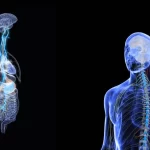In a quiet exam room in Boston, a 43-year-old man sits across from his health professional—not for a cholesterol check or prostate screening, but for something far less familiar: a vagus nerve assessment.
He’s been struggling with chronic tiredness, anxious thoughts, and digestive issues that defy standard explanations. His health professional suspects the culprit may not be in his gut or glands—but in the long, wandering nerve that connects his brain to nearly every major organ.
The Hidden Power of the Vagus Nerve
The vagus nerve, Latin for “wandering,” is the body’s longest cranial nerve, extending from the brainstem to the abdomen. It plays a pivotal role in regulating heart rate, digestion, immune responses, and even mood. Yet despite its reach—and its regulation of functions essential to everyday health—it remains largely absent from the standard male check-up.
Recent research suggests that vagal dysfunction may be a silent contributor to a host of persistent problems: sleep problems, mood shifts, joint pain, and inflammatory gut issues. The question, then, is not whether the vagus nerve matters—it’s why it’s not already part of the mainstream men’s health conversation.
Recognizing the Signs of Vagal Dysfunction
Men experiencing vagal dysfunction often present with a constellation of subtle but disruptive symptoms:
- Sleep disturbances – Difficulty falling or staying asleep.
- Digestive trouble – Symptoms resembling irritable gut.
- Mood fluctuations – Unexplained swings into depressive states or anxious thoughts.
- Heart rate anomalies – Rapid heartbeat or low resting heart rate episodes.
- Cognitive fog – Trouble focusing, or feeling “wired but tired.”
Because these symptoms overlap with dozens of other conditions, vagus nerve issues can easily go misdiagnosed or untreated for years.
Subscribe for Free for more insightful health articles tailored to your needs.
The Science Behind Vagal Neuromodulation
The vagus nerve is the main component of the parasympathetic nervous system, the body’s “rest and digest” circuit. When it’s functioning well, it supports recovery, regulation, and repair. When it’s not, the body can be thrown into a chronic stress response—whether or not the person feels stressed.
One of the most studied indicators of vagal health is heart rate variability (HRV), a measure of the variation between heartbeats. Higher HRV generally signals better nervous system flexibility and resilience. In contrast, lower HRV is associated with chronic inflammation, reduced immune function, and stress-related disorders[¹].Newer techniques, like transcutaneous auricular vagus nerve stimulation (taVNS), allow health professionals to assess and influence vagal tone without surgery. Using mild electrical impulses delivered through the outer ear, taVNS targets the auricular branch of the vagus nerve to restore parasympathetic balance. Neuroimaging studies have confirmed that this method accesses brain regions involved in autonomic and emotional regulation[²].
Integrating Vagal Assessments into Men’s Health
Integrating vagus nerve assessment into routine men’s health exams could be transformative—especially for those struggling with chronic symptoms that haven’t responded to conventional therapies. Initial evaluations may include:
- Monitoring HRV via a wearable device.
- Physical reflex tests like the gag or carotid sinus reflex.
- Symptom pattern analysis tied to vagal influence.
When vagal dysfunction is suspected, one non-invasive approach growing in popularity is vagal neuromodulation. One option involves the use of a CE-marked non-invasive vagal neuromodulation system, which delivers low-level electrical stimulation through the ear to modulate vagus nerve activity. In studies of users experiencing depressive states, fatigue, or poor sleep, taVNS has led to measurable improvements in symptoms and HRV[³][⁴].
Subscribe for Free for more insightful health articles tailored to your needs.
A Case in Point
Back in Boston, the man who came in for that unexpected nerve check began using non-invasive vagal stimulation as part of a broader plan—alongside sleep hygiene, stress management, and diet changes. Within a few weeks, he reported better energy levels, fewer mood swings, and deeper, more restorative sleep.
His case isn’t unique. While more large-scale studies are underway, the growing body of evidence—and growing number of success stories—suggests this is more than a placebo effect.
Moving Forward
The vagus nerve isn’t a magic fix—but it’s no longer something we can afford to ignore. For men navigating complex symptoms with no clear diagnosis, or simply looking to optimize stress recovery and resilience, vagal assessments and neuromodulation offer an evidence-based path forward.If you’re interested in exploring this approach, talk to a qualified health professional about HRV monitoring, vagal tone assessments, and whether CE-marked non-invasive vagal neuromodulation systems may be appropriate for you
Note: The article does not in any way constitute as medical advice. Please seek consultation with a licensed medical professional before starting any treatment. This website may receive commissions from the links or products mentioned in this article.
📚 Endnotes & Sources
- Shaffer, F., & Ginsberg, J. P. (2017). An Overview of Heart Rate Variability Metrics and Norms. Front Public Health.
➤ https://doi.org/10.3389/fpubh.2017.00258 - Frangos, E., Ellrich, J., & Komisaruk, B. R. (2015). Non-invasive Access to the Vagus Nerve via the External Ear: fMRI Evidence in Humans. Brain Stimulation, 8(3), 624–636.
➤ https://www.sciencedirect.com/science/article/abs/pii/S1935861X14002366 - Hein, E., Nowak, M., Kiess, O., et al. (2013). Auricular taVNS in Depressed Patients: A Randomized Controlled Pilot Study. J Neural Transm, 120(5), 821–827.
➤ https://link.springer.com/article/10.1007/s00702-012-0908-6 - Nurosym – Scientific Evidence Overview.
➤ https://nurosym.org/pages/scientific-evidence



